These photographs were all taken on a disposable camera over the summer in party and festival settings.
![Screen_Shot_2015-11-03_at_09.02.13[1]](https://hautlieucreative.co.uk/photo16a2/wp-content/uploads/sites/2/2015/11/Screen_Shot_2015-11-03_at_09.02.1311.jpg)
![Screen_Shot_2015-11-03_at_09.02.44[1]](https://hautlieucreative.co.uk/photo16a2/wp-content/uploads/sites/2/2015/11/Screen_Shot_2015-11-03_at_09.02.441.jpg)
![Screen_Shot_2015-11-03_at_09.02.56[1]](https://hautlieucreative.co.uk/photo16a2/wp-content/uploads/sites/2/2015/11/Screen_Shot_2015-11-03_at_09.02.561.jpg)
These photographs were all taken on a disposable camera over the summer in party and festival settings.
![Screen_Shot_2015-11-03_at_09.02.13[1]](https://hautlieucreative.co.uk/photo16a2/wp-content/uploads/sites/2/2015/11/Screen_Shot_2015-11-03_at_09.02.1311.jpg)
![Screen_Shot_2015-11-03_at_09.02.44[1]](https://hautlieucreative.co.uk/photo16a2/wp-content/uploads/sites/2/2015/11/Screen_Shot_2015-11-03_at_09.02.441.jpg)
![Screen_Shot_2015-11-03_at_09.02.56[1]](https://hautlieucreative.co.uk/photo16a2/wp-content/uploads/sites/2/2015/11/Screen_Shot_2015-11-03_at_09.02.561.jpg)
In the half term I visited Southampton due to a university test that I had to do. I was there for 2 days. I only really visited the town where the shopping centres were so didn’t experience much of what there society is like. It was a very dull town so I wasn’t inspired as much as I thought I was going to be. I didn’t take many photographs as I didn’t feel very inspired. I have taken a couple of images from the train station that I liked. A lot of my pictures have motion blur as I like the idea of having motion in a photograph. I took these images on my phone and added the iPhone effect ‘noir’. I like the pictures of the train station as they look very gloomy which perfectly represents the place.

On Friday 23rd October the whole of year 12 and 13 photography students headed down to the Jersey Art Museum where we were delivered an opportunity to get our creative work exhibited within the Jersey Museum. This was created to celebrate 125 years of the Jersey Evening Post [originally named Evening Post]. This would be a really great opportunity to get our work out there within the Jersey community as well as actually being a part of an exhibition.
“Your Story, Our History: 125 years seen through a JEP lens”
The Jersey Archive only managed to find images from the past 85 years so it wasn’t really true to its name, however the images that I saw were really interesting. The reason why some of the photographs weren’t present was because during World War II the German Nazis took over Jersey and the JEP and so before the Germans took over the JEP the head of the JEP decided to burn all of the papers and images so that the German’s couldn’t get hold of them. This is really interesting as I wonder why this person wouldn’t want the German’s to see those images or papers even though they wouldn’t really be able to do anything with them unless they had important news about Britain and possible war moves. I find that although they were unable to bring images across the 125 years it still has huge impact and is really important in the growth of Jerseys history.
Our photographic role
125 hours seen through a teenager’s lens
So for this exhibition our task is to make images through the lens of a teenager over 125 hours, as the Archive doesn’t really have images made by teenagers and we never really get a teens perspective on things. I think that this is a really great idea because often adults underestimate teens and think that all we ever do is cause trouble which is not the case. This really helps with the documentary aspect of our photography course as we are able to apply this to our own work and use it to our advantage. I want to be able to make the most realistic images that I possibly can by just carrying my camera around with me constantly and snapping shots at random [action shots]. This will be a fun experiment and I’ll be able to look back and see what I was doing at different moments throughout my week. Basically 125 hours amounts to 5 days and so we will be making photographs across a five day period. Another role that students are able to get into is actually creating the exhibition on the day. There will be 10 students selected from those who put their names down and here they will be split into teams of about 2 or 3 people, the curators, designers, PRs and documenters. Here we are going to be able to choose the best photographs from all the students, position them and decide how they are going to be placed in the exhibition space as well as filming and documenting the day through photographs. This will be a really great experience and a good chance to get our work out there. The deadline for this exhibition is Wednesday 18th November.
During the day we went down to the exhibition to check it out I was given the opportunity by Lucy Layton, from the JEP and head of the 125 hours project, to actually film throughout the day of the takeover as well as taking over their Facebook and Instagram page. I think that this will be really interesting to do and I want to be able to make a decent video for them as it is going to be posted on their website. Here I want to interview some people involved with the project including students involved. I will also be filming throughout the day of different decisions being made and possibly a time lapse of the entire day filmed with my GoPro. I am going to come up with some questions to ask during each of the mini interviews as well as filming different shots of the exhibition throughout the day as more behind the scenes stuff.
Archival images: http://jerseyeveningpost.newsprints.co.uk/search/byg/p/u/48/1/jep_125th_anniversary_exhibition_images
At first approach to the exhibition I thought ‘I hate the red’, for me the colour red is just awful but that is however just personal preference and I know that the red iconically represents the Jersey Evening Post. For some reason I just find that the colour red is so harsh and can be quite in-your-face at times but then again it did really compliment the black and white images making them stand out from the wall a lot more. I find that even the background of an exhibition matters so much because it can completely change the way the spectator sees and interprets the images being exhibited. I absolutely love that all of the images are in black and white, mainly because the time they were taken film cameras only shot in black and white but nonetheless I loved it. I find that this really allows the spectator to look into the image and the people within those images instead of being sidetracked by bursts of colour in different parts of each image. All of the images managed to compliment each other because they were all black and white they seemed to have a more equal chance of being looked at. I did find that the middle of the room was lacking something, which would make the perfect space for our additional new images that are selected for the archive as that was the intention. I was also drawn in at the very beginning just down to the right side of the exhibition as you walk in there is a glass case filled with some awesome vintage photographs and film cameras. The film cameras were so great, as I’m a lover of vintage cameras, it really brought the whole exhibition into perspective for me in that people actually used to use these to make photographs for the papers and looking around at the images they were all so amazing without any editing being done at all [aside from the built in factor of them being in black and white].
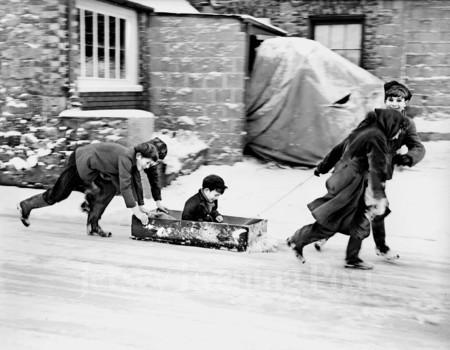
This is the first image that really stood out for me. I don’t have anything that I particularly like about this image accept I just love looking at it and it really comes together. It brings me a sense of nostalgia of when it snowed a couple of years back in Jersey and me and my friends from around my flats would constantly hang out and mess around in the snow. I think that this image will bring a sense of nostalgia to many people and those of all ages are able to relate to this in some way or another. The little boy sat in what looks like an old suitcase with a bit of string attached looks so happy and cute that his older friends/possibly siblings are pushing him along so that they can all enjoy the snow together. I really think that this photograph is cute and makes me happy, it is so simple and straight forward. Everyone in the photograph looks so happy. It makes me think about being younger and having no worries, being able to just do whatever I wanted and hang out and mess around with friends, even though I still kind of do that now. The composition of this image is great as the subjects are perfectly positioned with the same amount of space on either side of the image which I find so interesting as this would have been taken with a film camera where it becomes harder for the photographer to make such a perfect photograph as there was no such thing as adjustments and cropping then. I just love that this is an action shot and really makes me fall in love with the idea of documentary photography. This idea of taking action shots and film cameras makes me think of disposable cameras and when I was younger I used to use those disposable cameras to make images on different trips with my friends and family. I’ve actually started using them again because I love the idea of making images and then not being able to look at them until they’ve been developed, it’s much more fun to be able to collect them and finally get them and laugh and smile at all of the good times that we would usually overlook.
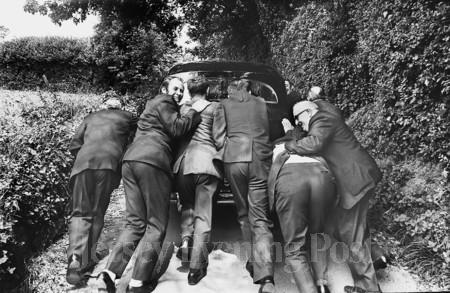
I think that this photo is great, I find it humorous. I find it almost comical that the photograph was taken from behind the men trying to push that old car through the countryside lanes around Jersey. I like that all of the men are facing away from the camera accept two of them, one turned round laughing [to the left] while the other seems to be smiling at the struggle they are having [to the right]. I find this image interesting as there is a lot to look at and I also find it quite funny that the men are wearing full suits when travelling round the countryside as if they were possibly businessmen or maybe that was just the fashion of the time. This image is entertaining and is open for interpretation to the spectators. I really don’t think that this image would have made it into the JEP because it isn’t really news but then again it is funny to look at and would put a smile on peoples faces. I find that most of the images being shown at the exhibition aren’t exactly the best images in terms of photojournalism and making headline Jersey news but I do think that they are great documentary images as they really do capture moments in time of Jersey history and the ordinary people of our small island. I find this interesting as I think I wonder what ever happened to those people and how old they are now and whether or not they are still alive.

Admittedly I hadn’t even come across this particular image until we were sharing our favourite photographs at the end of the session last Friday. Once it was pointed out to me it really made me start thinking about how even in Jersey women were seen as second-class citizens to their male counterparts. Everyone just looks so unhappy there as if it was an obligation to come from work on a friday and go down to the pub for a drink with their colleagues and their wives. In this image the women seem to be taking a step back and are always stood behind their husbands as if they aren’t as important as the men and are just there to look pretty and to socialise with the other wives. I find this image very sad and something that I just wouldn’t think would have happened in Jersey and I do not know why I thought that because Jersey is very backward in equal rights of all people, including only bringing in discrimination laws last year [2014] along with discrimination laws to protect characteristics of sex, sexual orientation, gender reassignment & pregnancy and maternity only coming into the law on 1st September of this year [2015]. I should really expect these kinds of images from Jersey as they have always been quite backward in laws as well as equal rights for women [still not equality of payment in some working environments]. The chandelier in the background interests me as it seems as though this would have been a more upperclass establishment so the only people that would be there are businessmen and their wives. I think that this can be a very powerful image as it explains a lot without saying anything, in the position of the women and the expressions on everyones faces. It is interesting to see a small section behind the bar with drinks lined up underneath that really shows how different everything is now in terms of the way people dress and the different class of people that you will tend to see hanging around bars nowadays compared to back then.
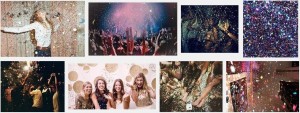
A friend of mine is having her 18th birthday party at a heritage site in Jersey. The party is going to be held at L’Etacquerel Fort on November the 14th. The party is also glitter theme so I have a few ideas for images. I especially think the glitter will look really effective in the photographs. This will relate to the theme of community as our friendship group is a big community, we are all basically like family so I am hoping to capture some images that reflect that. Iam photographing this party due to my recent study on community for Corinne Day. One of her shoots was based on the party scene, I intend to take some similar pictures for a shoot for community.
Martin Parr is a British documentary photographer and photojournalist. He is known for intimately looking at modern life in a critical way especially through documenting different social classes within England and more broadly documenting the wealth of the western world through anthropology, being the study of human beings and their ancestors through time. In 1994 he became a member of the Magnum Photos he has published 40 solo photobooks and has been part of 80 exhibitions world wide. Martin has also won many awards for example more recently in 2014 he won a Lucie Award, Achievement in Documentary Photography and an award for an Exceptional Achievement in Photography, Amateur Photographer, London.
The Last Resort
“…if the seaside was tatty, and more than a little run-down, it was also vibrant.” – Martin Parr
In 1982 Parr and his wife moved to England permanently, where he switched to colour photography being inspired by photographers work such as William Eggleston and Stephen Shore. During the summers of 1983, 1984 and 1985 he photographed the working-class people at the seaside in nearby New Brighton a couple miles from Liverpool.
I think that the composition of this photograph is good because, the woman’s head was cut out of the photograph however in the reflection of the mirror we can see her face as if she is about to eat something. This picture is also environmental, it shows litter scattered all over the floor which allows the viewer to interpret what type of place the picture was taken in. The photograph also captures emotion the little boy seems to be red in the face from crying. The photograph was taken from a right angle rather than standing in front, I think this makes it look more like an outsiders perspective and the people in the photograph are probably not aware that the photograph is being taken. There are no bright colours in the photograph apart from a speck of red from the coke can however I think the photograph is still eye catching however I can’t grasp why.
For 125 years, islanders of Jersey have been reading the Jersey Evening Post. Through their visual storytelling, press photographs can tell remarkable and untold stories, inspire discussion and reminiscence. For much of its history JEP photographers have documented Island life, following the daily activities of Islanders and recording the changing landscape and cultures which have developed insignificantly over time to create the Island we live on today. On Friday 20th November, we went to the John de Veulle Gallery, Jersey Museum to conduct research on Jersey’s Heritage. The JEP’s proposal was that Jersey Heritage participates in the national Takeover Day campaign to encourage children and young people across the country to get involved behind the scenes at museums and art galleries. Echoing the structure of a modern newspaper, this exhibition has shown highlights from the hundreds of thousands of photographs which have appeared over the year, from headline stories, news events, community features, entertainment and sport.
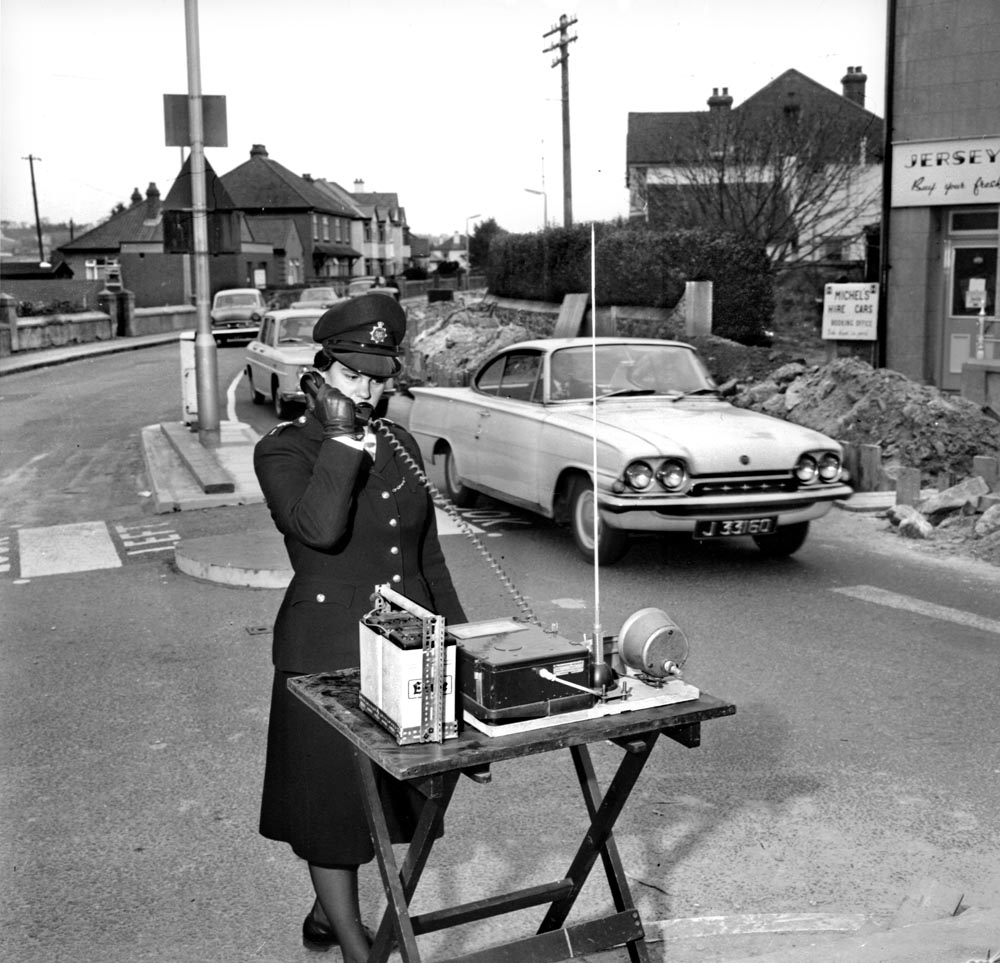
At the museum we had the opportunity to partake in the following roles:
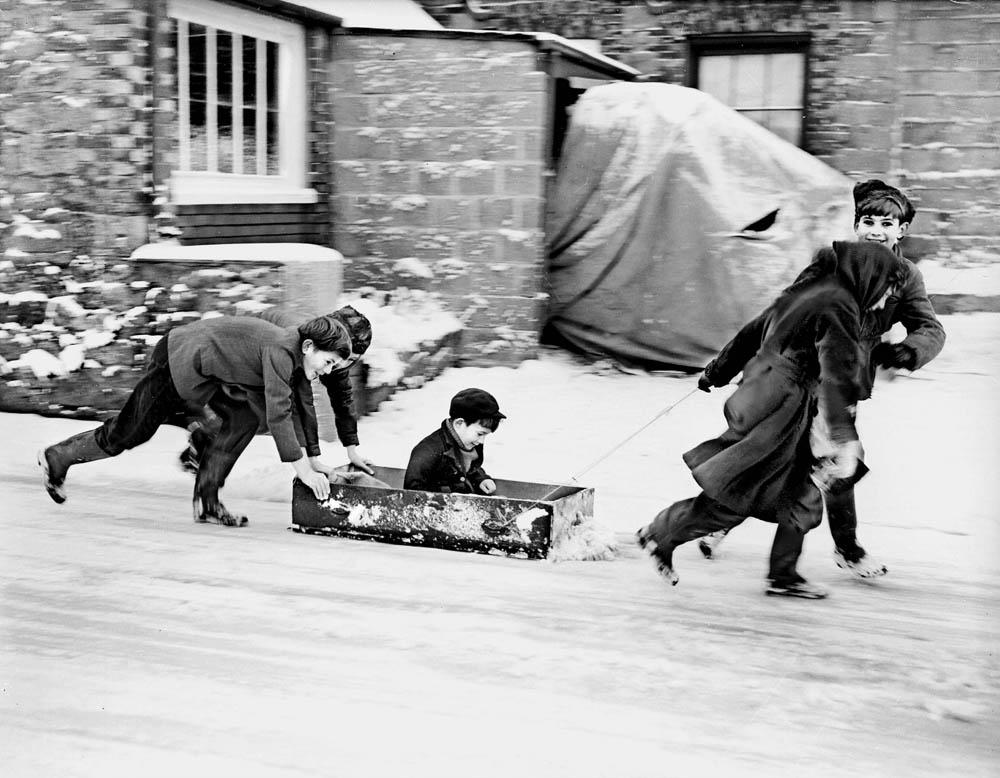
This collaborative project has given me a chance to work behind the scenes with Jersey Heritage staff to curate and mount a pop-up exhibition. This has provided me with an excellent experience at museums and art galleries. Jersey Heritage has benefited me from developing a close working relationship with young people and their responses will enrich our understanding and knowledge of the collection.
What effect did the exhibition have on you?
What where your favourite images from the exhibition?
What do you think the photographer is trying to communicate with this image? What is it you like the most about this aspect?
What is wrong with your least favourite image? How do you think it could be improved?
Can you see any revelations within a selection of images?
Here is a link to the photographs of the exhibition from the website – http://jerseyeveningpost.newsprints.co.uk/search/byg/p/u/48/1/jep_125th_anniversary_exhibition_images
Jersey Museum Takeover
Students at Haultieu have been offered the opportunity to be involved in a collaborative project with Jersey Heritage. We will have the chance to work with staff at Jersey Museum behind the scenes and mount a pop-up exhibition on Friday 20th November 2015. On Friday 23rd October we will be going on a trip to the Jersey Museum in order to engage with the images and gain experience and inspiration. The exhibition was held to to mark the newspaper’s 125th anniversary. It consists of a snapshot of the photographic archive, which goes back nearly 100 years. The assignment is to produce a response to the exhibition, Your story, our history: 125 years seen through a JEP lens. However, our version will be your story our history: 125 hours seen through a teenager’s lens.
The first thoughts that entered my head when I walked into the exhibition was the contrasting colours of the red background and the black and white photographs. I thought that it was clever to present the images in this way because it captured your attention, plus, the neat and precise display may it easy to understand which photographs went with the text. I also thought the photographs which had people as their subject were the most interesting to me; they stood out for me. However, overall I thought the exhibition came across very confusing, I didn’t understand why the project was called 125 years when only approximately 50 years was displayed. Also the little tiles of text were quite random and didn’t always clearly correlate with the image closest. In my opinion, I think the photographs would look more aestheically pleasing if they were displayed in a better way, possibly more spacing between the images and making them a better quality print as well as enlarging them.
The three images below are my favourite photographs from the exhibition mainly because they all incorporate people and society into the theme. The first image I selected as one of my favourites was because I like the authenticity of it, it feels almost movie like. I like the black and white style because it looks sophisticated and brings out the tones.
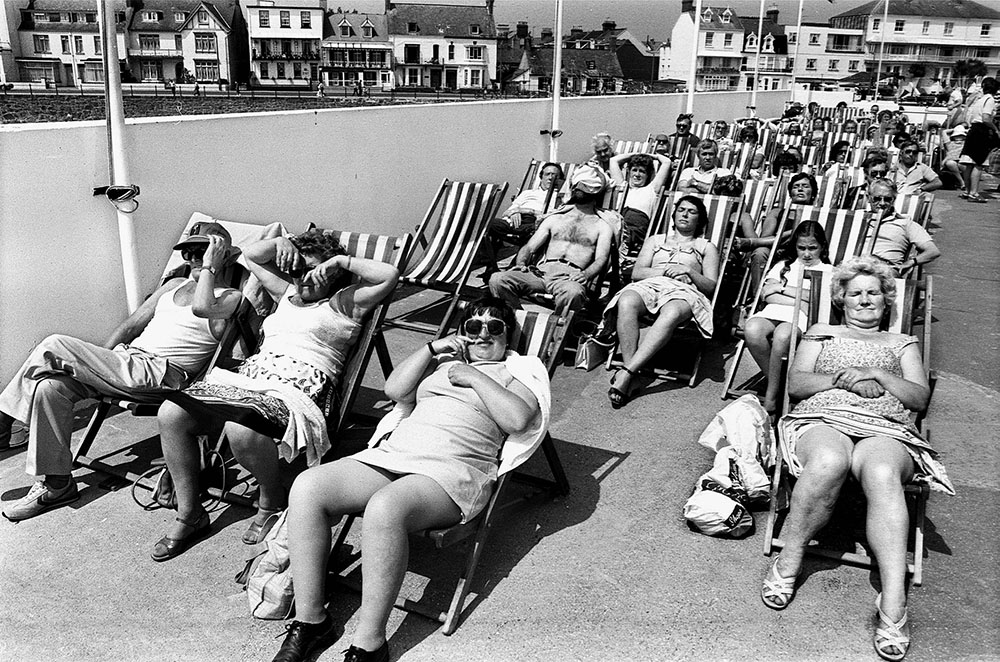
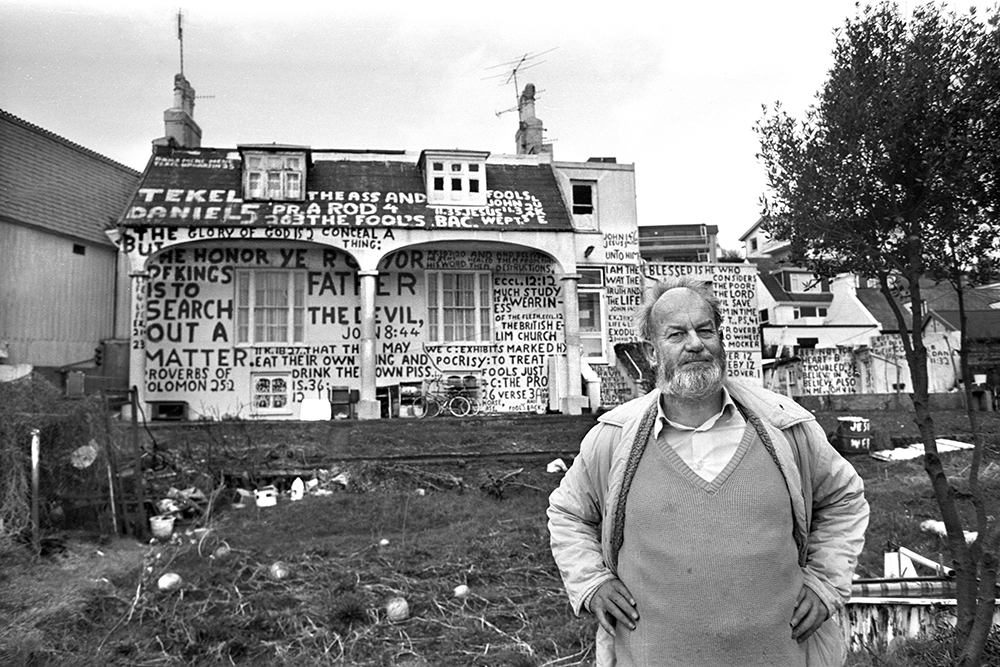
The reason I picked this image as my favourite from the exhibition is because it represents women fighting for something they feel passionate about. I also like the angle it has been taken at, it offers a different perspective showing all the women’s faces from young to old. It is an inspiring image which shows a variation of textures and depths. Furthermore, the framing is also extremely important in this photograph, it captures the power and enthusiasm the women feel.
I don’t have a least favourite photograph in the exhibition because I think there are some photographs that really stand out and then the rest are average. In my opinion, as I mentioned earlier I don’t think the images were shown to the best of their ability; they could be a great deal more powerful. Although, I didn’t particularly understand the photographs of the Jersey Evening Post being made in the early years of its existent. I didn’t like these images as much because I don’t think they are that interesting or inspiring.
Lots of the photographs in the exhibition show similar events or activities to what I will be doing in the half term. The landscapes in the photographs are the same as today because the buildings have been kept the same. A great deal of the images involve people from the island which I think is an important aspect to consider.
Henri Cartier-Bresson is a well known and successful photojournalism photographer. The Paris born man was the co-founder of the successful Magnum Photos Agency.
He used to be an ordinary photographer until he saw a certain image. In fact he was moved by a picture that was taken by Martin Munkacsi. This 1930’s picture had many tones and contrasts, that fascinated Cartier-Bresson. He stated: “I must say that it is that very photography which was for me the spark that set fire to fireworks”. He referred to the picture below:

“As far as I am concerned, taking photographs is a means of understanding which cannot be separated from other means of visual expression. It is a way of shouting, of freeing oneself, not of proving or asserting one’s own originality. It is a way of life.” – Henri Cartier-Bresson.
He first wanted to be known as a ‘Surrealism’ photographer, but was soon told that that wouldn’t be very successful as the world wouldn’t take that title seriously. Therefore he changed it to ‘Photojournalist’ and then he continued his passion.
His first book was called ‘Decisive moments’. It was what established him as a photographer and inspired many other people. Cartier-Bresson photographs people in a ‘candid’ way that reflects onto his photojournalism. His amazing work got him known as on of the ‘Fathers of Photojournalism’, which is a great honor. Here’s a picture from the 1st book:

He got his title ‘The decisive moment’ from the following quote: “There is nothing in this world that does not have a decisive moment”, which was said by a 17th century French Cardinal.
I think that the picture above is a great photojournalism picture. The two extremes add impact and create polarization. Polarization is two completely different concepts and views of each other. In this case the two main things are war and peace. The men on the left are holding sharp weapons and are pointing them in an aggressive fashion. Meanwhile the woman on the right looks completely relaxes and innocent. Her non-malicious body language demonstrates that she is completely at ease. This is great because it portrays a very interesting meaning. The woman may be trying to communicate that she see’s beauty in the littlest things, such as the flower she’s holding. Cartier-Bresson has maintained a great composition by balancing the two ideals in a symmetrical manner. The leading lines are also efficient and work well as the weapons point to the woman and the flower points to the men. Symbolically, weapons are a representation of the following: war, aggression, male power, power, anger, defense, pain, revenge, sacrifice, betrayal and more. On the other hand, flowers represent the following: happiness, freedom, nature, natural, patient, cheerful, life, innocence, hope, health, everlasting love, friendship, devotion, sympathy, youth, devotion, faithfulness and more. Therefore, the two majorly different ideals create a very fascinating photograph.
Here are some other famous pictures of his:

“Of all means of expression, photography is the only one that fixes a precise moment in time” – Henri Cartier-Bresson.

“In photography, the smallest thing can become a big subject, an insignificant human detail can become a leitmotiv” – Henri Cartier-Bresson. A ‘Leitmotiv’ is defined as: ‘A recurrent theme that’s associated with a particular person, idea or subject’.
I found a website that includes 29 of Henri Cartier-Bresson’s best quotes: http://www.johnpaulcaponigro.com/blog/12018/29-quotes-by-photographer-henri-cartier-bresson/
Ideas of Family:
With the recent development of my life as a family, it is suitable to base this project on the transition of me moving house in early December 2015. This building project has been live for nearly over 5 years, and has been a long process due to the reserves for materials, dealing with the National Trust and allowing the correct methods to be done in order to restore the house’s natural and original form. Le Petit Fort, for nearly half a decade has become the pivitol force within our lives as a family. Both of my parents have spent countless hours on the development of our new family home, as they have effortlessly incorporated the minimalist details of their own lives with reflects on what life was like when the house was first originally built.
As a starting point, I have researched past images of the house in order for me to make a comparative link to suggest more relevance within my ideas. This was all done with help from the Societe Jerseiase and Jersey’s Photographic Archive. With help from Gareth Syvret, we researched these past images of the house with the references tagged along with the images. This was all stored in a box of photographs given by the Bailiff of Jersey, between the era’s of 1930’s and 40’s: a post war memorial. I then learnt that my house was an important artifact and gem to the German soldiers which were residence in St Ouen’s Bay during the time of the occupation in World War ll. From this, my ideas then began to develop, I found relevance into my project by being able to contextualize and relate to the history of my new house.
This aspect for me is very interesting, and I would like to investigate these factors in greater depth by recreating this style myself. The style and resiliency of the prints when disposed are unconditional to the time period and era. The rustic and compound prints objectifies images in greater detail, as colours are abbreviated allot further along with edges and geometry created from sharp lines. This could be captured with use of a disposable camera. Exploring this theme of disposables allows me to reconnect back into my childhood, as a way of integrating with the present without compromising and changing the perceptions of the past. For me, as a kid, using disposable camera was a source of fun for me and my family. The camera acts almost as a time capsule, reflecting back on the times humorous and laughable things that wouldn’t usually be remembered by memory. As a kid, using this camera as a game enabled me to take chances with the outcomes, as once taken, I would look forward to the interpretation of the moment once developed.
As you can see from these pictures, a sense of history is elevated. I want to approach this task open-minded, as from 2010, the growth and development of our family has changed and continues to change with a developing world.
I plan to initially capture my dad as the driving force of this project. He began this project initially from his idea, he was the one that initiated this move and constructed the foundations of the house as well as the various plans.